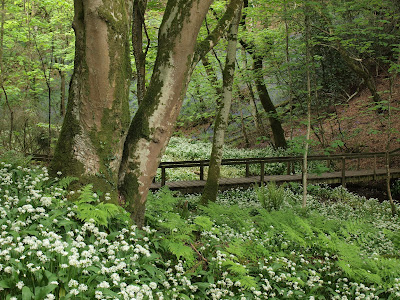Its been a lovely summer so far, and this week has kept up the trend of blue skies and sunshine. Much like the weather, our birding has also been very good this week. We've had quite a few irregular species, including returning species, fledging birds, and even a rare gull record.
Last week when I was looking at our gulls, I mentioned the offhand possibility of seeing Mediterranean or Yellow-legged Gulls. I did not expect to be so prophetic, as one of the latter turned up on the Scar this past Tuesday. We had additional records of a Yellow-legged Gull on Thursday and Friday, but as they were all adults, it is likely that they were all the same bird that had decided to stick around for a while. It could still be about, however, in amongst the Herring Gulls, it is very tricky to spot. It takes practiced eyes to pick them out (so neither of mine!), but its still good to see one so early in the year. Hopefully we'll get even more as winter rolls around!
Speaking of early birds (no worms for these sadly), some more wintering species are starting to appear. Previously we've seen some waders on our shores, but this week we've had some early arrivals on the loch as well. Red-throated Divers are normally a wintering species for us, indeed Loch Ryan is considered nationally notable for the numbers which we get. Some are just a little too keen to spend time with us however, as a lone diver was recorded this week. Another such species that we haven't seen in a while are Great-crested Grebes. Whilst they do breed locally within the UK, they prefer fresh-water lochs and so they disappear from our shores for this brief period of time.
Over the past few weeks, we've seen a lot of juvenile birds across many different species. This week it was the turn of our raptors, and we started it off with a juvenile Buzzard. Still very much a young bird, it was making a lot of noise, no doubt wanting food and attention! This was then later supplemented by a pair of juvenile Peregrines. We have Peregrines breeding in our surrounding areas, so it's possible that these could be local birds. Regardless, they are always nice to see.
As always there is lots to hear around the wig, and birds cry out from up above in the sky, behind the hedges, and amongst the treetops. This week's singers included Willow Warblers, Song Thrushes, and five Skylarks. We also had records of a Whitethroat, Nuthatch, and even a singing Meadow Pipit, something we've not heard these past few weeks. Finally, whilst not as vocal as these others, it was also really nice to see four Stonechats, a male, female and two juveniles, so perhaps a whole family. Later in the week a male was seen carrying food, so there must still be hungry mouths to fill somewhere!
In my second instance of foresight, my previous prediction of regular dolphins came true! Increasing their numbers, this week we had five Bottle-nosed Dolphins within the Loch. Whether they come in to feed, or just to ride the waves along the bows of ships we're not sure, but we're certainly happy to be seeing them so often, and in good numbers too.
That about wraps it up for this week. It certainly was surprising to see many of these wintering species this early in the year. Perhaps that is a trend we will see in future years, but so long as they keep bringing up more interesting birds, I guess we cant complain!
[All photographs were taken by and belong to Stephen Grover, please ask for permission if you wish to use them.]










